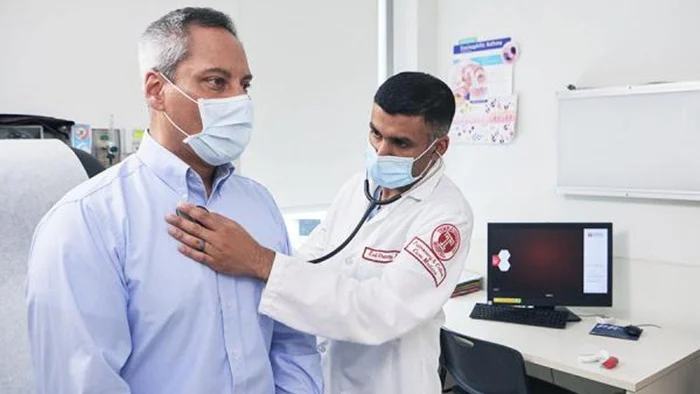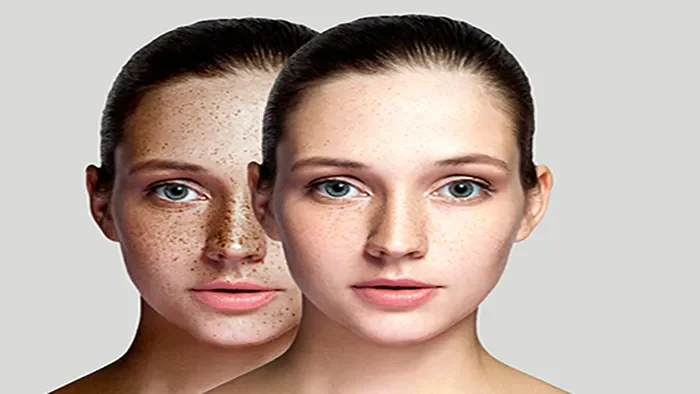Vitiligo can be developed due to a lack of Melanin. Melanin is a natural substance found in the body that gives color to the pupils of the eyes, hair, and skin. Melanocytes, which are skin cells, produce melanin in the body and it acts as a natural sunscreen, providing protection from UV rays, but it doesn’t prevent sunburn entirely.
The amount of melanin in the body determines its ability to produce vitamin D, which is an essential nutrient made when exposed to sunlight. Melanin levels vary based on the strength and duration of sun exposure.
In addition, changes in hormones can affect melanin levels, leading to lighter or darker skin. People with higher melanin levels have darker skin, while those with lower melanin levels have fairer skin. Melanin is important for various aspects of health and has various effects on the body.
A lack of melanin is associated with several problems, including vitiligo and albinism, resulting in discoloration of the eyes, hair, and skin. Other symptoms include sensitivity to light, vision problems, and squinting. Doctors diagnose this condition based on symptoms and physical examination and may suggest genetic testing or skin biopsy to confirm the diagnosis.
Albinism, or skin discoloration due to a melanin deficiency, is a genetic problem that cannot be prevented. To manage the condition, protecting the skin from the sun, using sun protection creams, or undergoing UV light phototherapy, corticosteroid creams, or medications like psoralen or tacrolimus may be recommended.
Melanin deficiency can result in several complications, including skin cancer, reduced vision, stress, emotional stress, and social isolation.
What is melanin deficiency?
“Melanin Deficiency” refers to the condition in which the body produces less melanin than normal, leading to white patches on the skin (vitiligo) or complete discoloration of the skin.
What are the symptoms of lack of melanin?
The main symptom of vitiligo is the formation of discolored or white spots on the skin, mainly due to a deficiency of melanin. These spots typically appear on sun-exposed areas of the body, such as the hands, feet, arms, face, and lips.

At first, the spots may appear as slightly paler marks, but over time they turn yellow to white. The white spots may grow over time and cycle through periods of formation and stability. Vitiligo does not typically cause discomfort, itching, pain, or dryness.
The spots do not have a specific shape and may be accompanied by slight swelling, redness, and itching. They are commonly found in the elbow, knees, foot, navel, back of the hand, arm, nose, eye, genital area, anal area, mouth, armpits, and groin.
In albinism, symptoms include discoloration of the skin, hair, and eyes, lighter-than-normal eye, skin, and hair color, and patchy discoloration compared to normal skin. If amblyopia is present, symptoms may also include squinting, poor vision, blindness, light intolerance, and involuntary eye movements.
When should I see a doctor?
If you notice any worsening of your skin, hair, or eye color, it is recommended to see a doctor. Early diagnosis of melanin deficiency can help reduce or stop the discoloration and return the skin to its normal color.
What causes a lack of melanin? What is vitiligo caused by?
If your body produces too little melanin, your skin becomes lighter in color.
Vitiligo is a condition that causes patches to develop on the skin. The color of hair and skin is determined by melanin, and vitiligo occurs when the cells that produce melanin are destroyed or stop functioning. This condition can affect people of any skin color, but is most common in those with darker skin tones.
The cause of the cells dying or stopping to function is not fully understood by doctors, but it may be related to:
- A disorder in which the immune system attacks the cells that produce melanin.
- A family history of melanin problems.
- Triggers such as sunburn, stress, or exposure to industrial chemicals.
Albinism is a genetic disorder that affects a person’s skin and is present from birth. It is caused by a defect in a gene that produces or helps produce melanin, which results in reduced melanin production or a complete cessation of melanin production. This defective gene can also be passed down from parent to child, causing albinism.
Other reasons for the lack of melanin include leprosy, tuberous sclerosis, and post-inflammatory hypopigmentation.
When does the risk of melanin deficiency increase?
The risk of melanin deficiency increases under certain conditions, including:
- Most people develop vitiligo around the age of 20, although it can occur at any age.
- Having a parent with albinism or a defective gene associated with it.
- Contact with chemicals.
- Burns or infections that cause blisters.
How can I prevent melanin deficiency?
It is not possible to prevent either form of melanin deficiency (vitiligo and albinism) as they are inherited disorders. However, taking certain precautions can make life easier for patients.
Protect from sunlight: Vitiligo often appears in areas of the body that are exposed to strong sunlight. Avoid excessive sun exposure and protect your skin from sun damage to prevent the development of vitiligo.
Reduce stress: Both physical and mental stress can contribute to melanin-related problems.
Wash and eat fruits and vegetables: Wash all fruits and vegetables thoroughly before consuming.
Improve nutrition and diet: A balanced diet is essential for skin health and to prevent vitiligo.
Drink plenty of water: Keeping the skin hydrated is important for maintaining its health, so make sure to drink plenty of fresh water throughout the day.
Take sun protection measures: Before going outside, wear sun-protective clothing or apply natural sun protection cream. This will reduce the effects of sunlight and prevent changes in skin color.
Minimize the use of chlorinated water: Avoid bathing in public pools or using water that contains chlorine, as this can affect skin health.
How do you check melanin levels?
If your doctor suspects that you have vitiligo, they will ask about your medical history and conduct a physical examination. They may also perform tests to rule out diseases such as dermatitis or psoriasis. During the physical exam, doctors can often detect vitiligo simply by looking at your skin. If someone in your family has vitiligo, be sure to inform the doctor.
Certain tests may be necessary for a proper diagnosis, including:
- Ultraviolet lamp test: This test, also known as a Wood’s lamp, uses ultraviolet light to check for vitiligo spots and differentiate it from other conditions.
- Skin biopsy: Your doctor may take a sample of your skin for examination in a laboratory to determine if melanin-producing cells are still present in the affected area.
- Genetic testing: This is the most accurate way to diagnose albinism, as it detects the defective gene associated with the condition.
- Electroretinogram test: This test detects cells in the eye that have become hypersensitive to light, which is associated with albinism.
How to increase melanin and treat vitiligo?
Using Sunscreen – Light spots on the skin are highly sensitive to light and can easily get sunburned. In this case, it is important to use good sunscreen.
Phototherapy with UV Light – The drug psoralen can be used in combination with UVA or UVB light therapy, as it makes the skin more sensitive to UV light. Sometimes, normal skin color returns as the skin heals.
Steroid-Containing Corticosteroid Creams and Ointments – The spread of white spots can be stopped by applying these creams and ointments. If some improvement is seen after a month, the use of the cream should be stopped for a period of time before the spots start to reappear.
Tacrolimus-Containing Ointment (Tacrolimus) – If small spots have formed, their discoloration can be prevented using this ointment.
Using Makeup Products – If there are light spots of vitiligo and the problem is not too severe, they can be concealed with the help of cosmetic creams or makeup products.
There is no cure for the melanin deficiency that causes albinism. In addition, doctors can improve eye problems associated with albinism, but it cannot be completely cured.
The main goal of treating albinism is to identify all symptoms related to the disease in the patient. People with albinism should protect their skin and eyes from the sun in several ways, including:
- Avoiding prolonged exposure to sunlight
- Using a high-SPF sunscreen
- Wearing sunglasses to protect against ultraviolet rays
- Wearing glasses as needed to correct vision problems
- In very rare cases, surgery may be necessary.
- Covering the skin completely with clothing before going outside in the sun
- Regularly checking the skin for skin cancer or other potentially harmful conditions.
What are the problems caused by lack of melanin?
People with Vitiligo are at increased risk of the following complications:
- Changes in vision
- Excessive tears
- Skin cancer
- Sunburn
- Other eye problems, such as swelling and redness of the eye
- Social and mental problems
- Hearing loss
- Problems caused by albinism, including:
- Increased risk of sunburn and skin cancer
- Social problems, such as bullying or physical violence
- Stress due to social problems, lack of self-esteem, and isolation from society.
What food causes melanin production?
Foods Beneficial for Patients with Vitiligo:
- Spinach and other green leafy vegetables
- Apples
- Bananas
- Dates
- Radishes
- Carrots
- Beetroots
- Gram.

